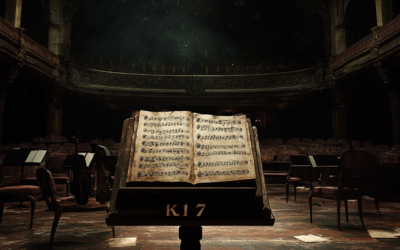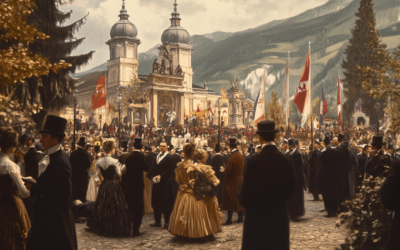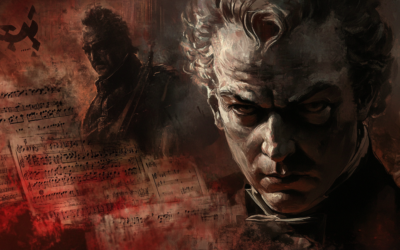The Adélaïde Deception
Mozart’s “Lost” Violin Concerto and the Art of Musical Forgery
In the early 20th century, the “discovery” of Mozart’s sixth violin concerto in Paris created a sensation. Dubbed the Adélaïde Concerto and supposedly written for Madame Adélaïde of France, it was hailed as a testament to Mozart’s genius. However, as the story unfolds, it becomes clear that this masterpiece was not the work of the child prodigy but rather a carefully orchestrated hoax by Marius Casadesus. Despite its unmasking as a forgery, the concerto continues to captivate audiences, raising questions about authenticity and the music industry’s willingness to deceive for profit.
Mozart: The Fall of the Gods
This book compiles the results of our studies on 18th-century music and Mozart, who has been revered for over two centuries as a deity. We dismantle the baseless cult of Mozart and strip away the clichés that falsely present him as a natural genius, revealing the contradictions in conventional biographies. In this work, divided into two parts, we identify and critically analyze several contradictory points in the vast Mozart bibliography. Each of the nearly 2,000 citations is meticulously sourced, allowing readers to verify the findings. This critical biography of Mozart emerges from these premises, addressing the numerous doubts raised by researchers.
"Even when proven false, the myth of Mozart prevails—because who wants the truth when the lie is so much sweeter?"
Mozart: The Fall of the Gods
The Discovery of a “Genius” Piece
In the early 20th century, the world of music was abuzz with the discovery of what was claimed to be a lost Mozart violin concerto. Named Adélaïde, this piece emerged from the depths of a Parisian safe that belonged to an elderly lady. The story goes that the concerto was composed in 1766 for Madame Adélaïde, the daughter of King Louis XV, during Mozart’s visit to Paris. The dedication, penned in a flowery and deferential style typical of the time, supposedly attested to the authenticity of the work. The sheer excitement of unearthing another piece from Mozart’s early years was enough to ignite a frenzy, leading to its publication in 1930 and subsequent performance with the Paris Lamoureux Orchestra.
The music world, eager for a new “genius” revelation, was quick to accept the piece. Paul Le Flem, a respected composer, confidently hailed it as an “extraordinary revelation of Mozart’s genius.” With a famous conductor like Albert Wolff and the support of celebrated violinist Yehudi Menuhin, who recorded the piece in 1934, Adélaïde swiftly entered the canon of Mozart’s works. It was officially catalogued as K.Anh.294a in the Köchel catalogue of 1964, a move that seemed to seal its authenticity. Once again, Mozart’s mythical genius was affirmed, and the concerto became a favourite in violin repertoires worldwide.
When Truth and Fiction Collide
But what happens when the truth comes out? Marius Casadesus, the man who had supposedly “discovered” and revised the concerto, later revealed that he was the actual composer. The music was not penned by a ten-year-old Mozart; it was a modern fabrication. Casadesus, initially offended by his lack of recognition and monetary gain from record sales, confessed to the deception. His motivation was clear—he had aimed to test the credulity of a music world hungry for myths, and he succeeded beyond his expectations.
The confession rocked the academic and musical community, exposing how easily experts could be deceived when confronted with a narrative that suited their preconceived notions. Musicologist Friedrich Blume had defended the concerto’s authenticity despite never having seen the manuscript. His rationale? The piece’s complexity and style were deemed entirely plausible for a child prodigy like Mozart. The eagerness to believe in Mozart’s “superhuman” abilities blinded scholars to the lack of concrete evidence, allowing a modern hoax to masquerade as an 18th-century masterpiece.
A Legacy Built on Lies
Even after Casadesus’s confession, the Adélaïde Concerto retained its allure. It remained in performance schedules, and record companies continued to sell it under Mozart’s name. Despite being reclassified as an apocryphal work (Anh 294a/C 14.05), the public still embraced it, clinging to the comforting illusion that it was a genuine piece by Mozart. Why? Because myths, once embedded, are hard to dislodge—especially when they feed the narrative of an infallible genius.
This is not an isolated incident in the history of music. Take, for example, the Adagio in G minor, attributed to Albinoni but actually composed by musicologist Remo Giazotto. The music industry has repeatedly capitalised on such forgeries, blurring the lines between truth and fiction to maintain commercial success. Record companies, eager to boost sales, have often been complicit, choosing not to disclose the real origins of these pieces. As long as the public is willing to accept the fiction, they are more than willing to keep the story alive.
Mozart’s “Sixth” Violin Concerto: A Case Study in Credulity
The Adélaïde Concerto serves as a cautionary tale for musicologists and audiences alike. It reveals how the obsession with preserving the myth of Mozart as an unparalleled genius can override critical thinking. When the music fits the narrative, questions about its authenticity become irrelevant. Even after Casadesus’s admission, figures like Alfred Einstein continued to ponder whether the work could still be connected to sketches Mozart might have produced in his childhood. The urge to cling to the “Mozart legend” is powerful, and even when presented with proof of a forgery, many prefer to look the other way.
The legacy of the Adélaïde Concerto, now officially labelled as spurious, reflects the stubbornness of the music world’s Mozart obsession. As long as the name Mozart guarantees commercial success, truth seems to be a secondary concern. The music industry’s reluctance to provide transparent information only fuels this trend, allowing the public to bask in a comforting, albeit false, sense of historical and musical continuity.
You May Also Like
Constanze vs. The Catholic Church
For over two centuries, scholars have debated the circumstances surrounding Mozart’s burial. Constanze Mozart’s supposed inability to mark his grave, the confrontation with the Catholic Church over funeral masses, and the baffling disappearance of Mozart’s body all contribute to a mystery stranger than fiction. Did a powerful group keep her silent? And what really happened to Mozart’s remains?
Constanze Mozart’s Enduring Love
Although some have doubted her devotion, Constanze’s own words and actions illustrate a widow deeply committed to preserving Mozart’s legacy. Diaries, personal correspondence, and eyewitness testimony all challenge the notion that she neglected his memory—while the circumstances around his burial grow ever more perplexing.
A Revealing New Interview on His Thematic Catalogue
We’re excited to present a brand-new interview that challenges many of the long-held assumptions about Mozart’s Thematic Catalogue (1784–1791). Conducted by Swedish journalist Henry Grynnsten, this conversation delves into groundbreaking forensic techniques—like advanced ink analysis and digital image processing—that may change the way we view Mozart’s late works.
The Rattling Symphony: A Critical Take on K. 17
Often attributed to Mozart, the K. 17 symphony is anything but refined. Lacking orchestration and filled with gaps, it raises more questions than answers about its true authorship.
The Hidden Origins of the Salzburg Festival: A Nationalist Dream
The Salzburg Festival, far from being a mere celebration of Mozart’s genius, was born out of nationalist ambitions during a turbulent period in Austro-German history. Conceived by figures like Max Reinhardt, Heinrich Damisch, and Friedrich Gehmacher, the festival was deeply rooted in ultranationalistic ideals, transforming Mozart’s legacy into a tool for cultural dominance. The truth behind its founding has long been obscured, but the primary sources tell a different, darker story.
Mozart, Wagner, and the Nazi Myth
The Führer’s admiration for Wagner’s racially charged ideology not only influenced the policies of the Nazi regime but also reshaped the legacy of Mozart. Under National Socialism, Mozart was not celebrated as a universal genius but as a symbol of German purity and superiority. His music, stripped of its international influence, was rebranded as an expression of Aryan identity, intended to unify and inspire the German people.







